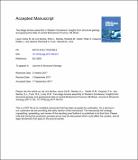Files in this item
Two-stage terrane assembly in Western Gondwana : insights from structural geology and geophysical data of central Borborema Province, NE Brazil
Item metadata
| dc.contributor.author | de Lira Santos, Lauro Cézar M. | |
| dc.contributor.author | Dantas, Elton L. | |
| dc.contributor.author | Vidotti, Roberta M. | |
| dc.contributor.author | Cawood, Peter A. | |
| dc.contributor.author | dos Santos, Edilton J. | |
| dc.contributor.author | Fuck, Reinhadt A. | |
| dc.contributor.author | Lima, Haroldo M. | |
| dc.date.accessioned | 2018-09-18T23:43:45Z | |
| dc.date.available | 2018-09-18T23:43:45Z | |
| dc.date.issued | 2017-10 | |
| dc.identifier | 251116704 | |
| dc.identifier | 1cbe21bd-970c-4a1d-86e8-6e7d26d21038 | |
| dc.identifier | 85032000065 | |
| dc.identifier | 000413378900010 | |
| dc.identifier.citation | de Lira Santos , L C M , Dantas , E L , Vidotti , R M , Cawood , P A , dos Santos , E J , Fuck , R A & Lima , H M 2017 , ' Two-stage terrane assembly in Western Gondwana : insights from structural geology and geophysical data of central Borborema Province, NE Brazil ' , Journal of Structural Geology , vol. 103 , pp. 167-184 . https://doi.org/10.1016/j.jsg.2017.09.012 | en |
| dc.identifier.issn | 0191-8141 | |
| dc.identifier.other | RIS: urn:1F6965C920A2FF3D44D4522CB85F14D3 | |
| dc.identifier.uri | https://hdl.handle.net/10023/16048 | |
| dc.description | ELD and RAF acknowledge National Council for Scientific and Technological Development (CNPq) financial support through INCT Estudos Tectônicos and research fellowships. PAC was supported by Australian Research Council grant FL160100168. | en |
| dc.description.abstract | Combined geophysical and structural data from the Transversal Subprovince of the Borborema Province (NE Brazil) highlight the internal structure of, and interrelationships between, the constituent terranes. Radiometric and magnetic maps show distinctive signatures for the Archean-Paleoproterozoic Alto Moxotó and Meso-to Neoproterozoic Alto Pajeú and Pernambuco-Alagoas terranes. Mapped radiometric and first and second order magnetic lineaments, associated with Euler deconvolution, enable correlation between geophysical data and major structures. In addition to early related deformation of the Alto Moxotó Terrane, combined analysis of late transposition foliations, lineations and kinematic criteria reveal a complex structural evolution marked by two distinct assembly stages. The first phase is characterized by thrust tectonics with top-to-the-south vergence, resulting in the juxtaposition of the allochtonous Alto Pajeú Terrane with the structurally underlying Alto Moxotó Terrane. The terrane boundary is delineated by the Serra de Jabitacá Shear Zone, which is associated with low dipping collisional granitic sheets and ca. 1.0 Ga mafic-ultramafic rocks interpreted as obtudcted ophiolite remnants. Later strike-slip movements strongly folded and obliterated thrust-related markers, and the continental scale E-W Pernambuco Lineament is interpreted as the result of lateral assembly between the composite Alto Pajeú-Alto Moxotó terranes and the Pernambuco-Alagoas Terrane during the metamorphic peak of the Brasiliano orogeny. Evolution of the Borborema Province reflects accretionary processes during the assembly of Western Gondwana. | |
| dc.format.extent | 3863302 | |
| dc.language.iso | eng | |
| dc.relation.ispartof | Journal of Structural Geology | en |
| dc.subject | Polycyclic deformation | en |
| dc.subject | Western Gondwana | en |
| dc.subject | Borborema Province | en |
| dc.subject | Accretion tectonics | en |
| dc.subject | QE Geology | en |
| dc.subject | GB Physical geography | en |
| dc.subject | NDAS | en |
| dc.subject.lcc | QE | en |
| dc.subject.lcc | GB | en |
| dc.title | Two-stage terrane assembly in Western Gondwana : insights from structural geology and geophysical data of central Borborema Province, NE Brazil | en |
| dc.type | Journal article | en |
| dc.contributor.institution | University of St Andrews. School of Earth & Environmental Sciences | en |
| dc.contributor.institution | University of St Andrews. Scottish Oceans Institute | en |
| dc.contributor.institution | University of St Andrews. St Andrews Isotope Geochemistry | en |
| dc.identifier.doi | 10.1016/j.jsg.2017.09.012 | |
| dc.description.status | Peer reviewed | en |
| dc.date.embargoedUntil | 2018-09-19 |
This item appears in the following Collection(s)
Items in the St Andrews Research Repository are protected by copyright, with all rights reserved, unless otherwise indicated.

